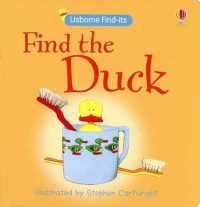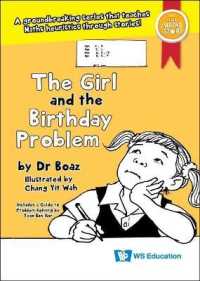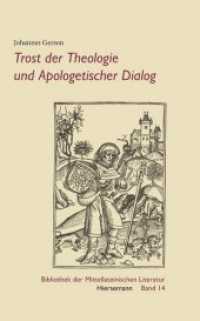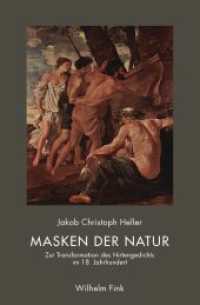- ホーム
- > 洋書
- > 英文書
- > History / World
Full Description
A class of child artists in Mexico, a ship full of child refugees from Spain, classrooms of child pageant actors, and a pair of boy ambassadors revealed facets of hemispheric politics in the Good Neighbor era. Culture-makers in the Americas tuned into to children as producers of cultural capital to advance their transnational projects. In many instances, prevailing conceptions of children as innocent, primitive, dependent, and underdeveloped informed perceptions of Latin America as an infantilized region, a lesser "Other Americas" on the continent. In other cases, children's interventions in the cultural politics, economic projects, and diplomatic endeavors of the interwar period revealed that Latin American children saw themselves as modern, professional, participants in forging inter-American relationships.
Contents
Acknowledgments
List of Tables and Figures
Introduction: Children, Empire, and Development in the Americas
1 Children and Youth Mobilized
2 Infantilized Subjects and Governability
3 Children as Subjects, Objects, and Agents
4 Chapter Organization
Part 1: Artists
Introduction to Part 1
1 Los tres grandes y unos chiquitos: Primitivism and Childhood in the Mexican Art Renaissance
1 The Infantilization of Latin America/ns
2 Childhood as a Metaphor for Development
3 Primitivism, Folklore, and the Indian in Modern Art
4 Institutionalizing Hemispheric Aesthetics
5 Conclusion
2 Primitive Geniuses: the Transnational Circulation of Children's Art from Taxco
1 Guerrero and Vermont
2 A Word about Rescuing Children's History from the Archive
3 Elsa Rogo and the Transnationality of the Open-Air Art School in Taxco
4 Taxco 1931: Primitive Paradise or Cosmopolitan Hub?
5 Techniques in the Taxco School
6 3,000 Miles from Mexico
7 Little Empresarios
8 Conclusion
Part 2: Exiles
Introduction to Part 2
3 Spanish Cubs of the Aztec Eagle: the Niños Españoles and Parenting as Statecraft
1 Manufacturing Public Opinion: the Spanish Civil War Comes to Mexico
2 From Mother Spain to Dependent of the Mexican State, 1519-1937
3 The Orphan Myth and Cardenista Family Metaphors
4 The Living Parents of Orphans
5 Conclusions
4 Tata Cárdenas and the Escuela España-México
1 The Escuela España-México
2 Tata Cárdenas: the Revolutionary Father Figure
3 Battle for Hearts and Minds: Communists and Catholics at the Escuela España-México
4 The Fate of the Niños de Morelia
5 Conclusions
Part 3: Diplomats
Introduction to Part 3
5 A Hemispheric Family Affair: Washington and the Other Americas
1 Pan-Americanism and the Two Americas
2 The Other Americas Talk Back
3 The PAU's Division of Intellectual Cooperation
4 Children's Exchanges as Official Pan-Americanism
5 Pan American Day
6 "We Make Sombreros!" Racial and Ethnic Representations of Latin America
7 "Once a Pan Am-er, Always a Pan Am-er": Pan Americanism in the US Classroom
8 Conclusion
6 Diplomats of Development: Children's Exchanges in a Wartime Economy
1 "Acercamiento Espiritual": Vertical and Horizontal Ties
2 A Tale of Two Roberts: the "Short-Pants Ambassadors" of Wartime Brotherhood
3 Promoting Resource Knowledge about the Other Americas
4 Conclusion
Epilogue
Conclusions: Two Americas, Other Americas, Nuestra América
Archives
Bibliography
Index








